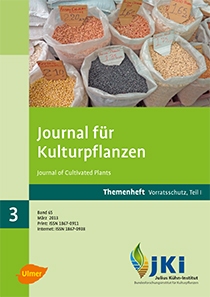Nanostructured silicas – Insecticidal effect and new developments
DOI:
https://doi.org/10.5073/JfK.2013.03.06Keywords:
Amorphous silica, diatomaceous earth, physisorption, desiccationAbstract
Modern research on the insecticidal effects of inert dusts as a stored-grain protectant and for plant protection purposes began in the 1920’s. The main advantage of inert dusts is their low environmental thread. One group of inert dusts used for pest control is amorphous silica. Amorphous silica has been tested as a whole and is according to the International Agency for Research on Cancer not classifiable as to its carcinogenicity to humans. Silica such as diatomaceous earths can kill insects by ab/adsorbing the lipids such as waxes and triglycerides of the outer cuticle layer by direct contact. When the thin, waterproof layer is lost, the insect dries out following Ficks law of diffusion into the surrounding atmosphere. Small particles with large surfaces are more effective than larger particles and some silicas show even surface structures within the nanometer range. The present manuscript describes the current use of amorphous silica in poultry systems, for stored product protection, as well as in horticultural production systems. New formulations are liquid rather than dusts. Particles used in commercial products are nowadays hydrophobic and not hydrophilic enabling a larger range of application.
Downloads
Published
Issue
Section
License
The content of the journal is licensed under the Creative Commons Attribution 4.0 License. Any user is free to share and adapt (remix, transform, build upon) the content as long as the original publication is attributed (authors, title, year, journal, issue, pages).
The copyright of the published work remains with the authors. The authors grant the Journal of Cultivated Plants, the Julius Kühn-Institut and the OpenAgrar repository the non-exclusive right to distribute and exploit the work.







